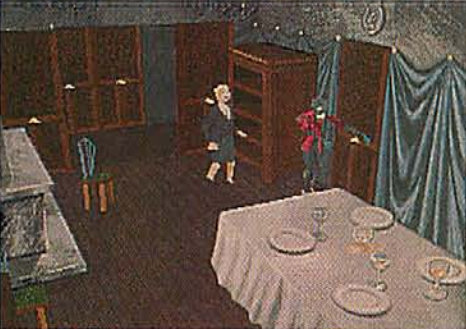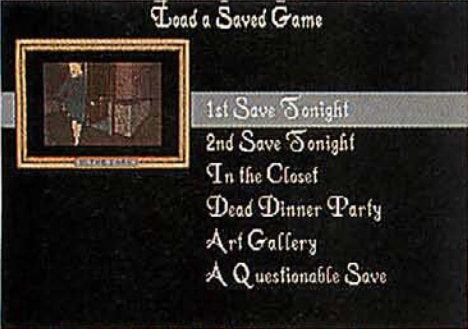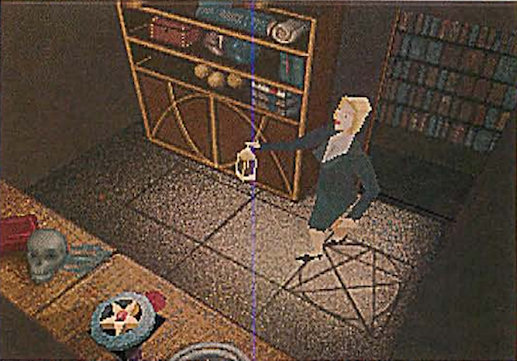Part 5: Epilogue: The Shape of Things to Come
Update:
"The Shape of Things to Come:
Polygon Technology in I-Motion's Horror Adventure, Alone in the Dark"
Computer Gaming World, February, 1993
By Chris Lombardi
It struck me as odd, pulling into the driveway of Interplay Productions in Irvine, CA, that the two most interesting horror adventure games of '93 were being produced just a block away from each other. Looking down the winding road of a planned commercial zone in one of the most notorious planned communities in Southern California (a scary thought in itself), I could see the distinctive red and white sign that marked the home of Virgin Games, where I knew that frantic programmers were working feverishly to finish their long-awaited and much hyped, 7th Guest.
While the Virgin team worked to stuff their technological behemoth onto two CD-ROM discs, I visited Interplay to discuss the beta version of a horror game that had materialized on my desk earlier that week. This game, entitled Alone in the Dark (Alone) and designed by the French developers Infogrammes and I-Motion (a new publishing partnership with Interplay), comes nowhere near the visual and technological splendor of the Virgin production, but it does use an old technology in a new way to produce a fresh and engaging 3-D adventure gaming environment. And, while we've yet to see much game-play behind the 3-D visual fireworks of 7th Guest, the 3-D technology used in Alone both creates a convincing 3-D work with visual flair and lends itself to complex and rewarding play. And it won't require a CD-ROM in order to enjoy it.

The "old" technology used in Alone is our dear friend, the polygon. The player assumes the role of a character whose image is composed of simple geometric shapes. As one will notice from the screenshots showing close-up images of the character, the result is rather rough -- resembling the creation of a child and her set of wooden blocks. My immediate reaction to this rough hewn image was a disinterested shrug. Then, I started moving this blockhead around the 3-D environment. After watching the character stroll casually about the room, pushing objects around, and bending over to examine and pick-up 3-D objects, I was beginning to understand what the designers were attempting to accomplish. Then, after my first deadly encounter with a bizarre reptilian duck, wherein my character punches and kicked, with great fluidity and a life-like agility, at the bill of this creature of Lovecraftian inspiration (and died as a result), my cold disposition began to thaw, and I restarted the game intrigued.
Alone in the Dark is set in the classic adventure game locale -- the haunted house. Since the very beginning, game designers have loved this setting for its discrete room structure and its limitless potential as a breeding ground for spooks, ghoulies, secret compartments and passages. Alone uses these conceptual design tools to good effect, creating a world where one is constantly looking over one's shoulder and searching every shadowed nook for the mechanism that reveals the secret study. Enhancing the effect of these haunted 3-D environs is the extensive use of "camera angles" to continually change the player's perspective. As one's character moves about a room, one's perspective will change many times; from a straight-away side-on pan, to an overhead "closet-set" shot, to an "inferior-view" from floor level, to many other perspectives in the visual grammar of cinema. While many rooms have only two such camera views, some have up to nine! When teamed with some nice sound effects (floors creaking with every step, eerie howlings, fiendish laughs, and growls from monsters), these changing perspectives have the effect of pulling the viewer into the environment in a similar manner as the effect achieved by Ultima Underworld and Wolfenstein 3-D, and, of course, film.
Gamers should be warned, however, that the unique cinematic angles sometimes get too clever. Swift changes in the viewpoint can occasionally be disastrous when the player's character is in combat mode. At the very least, these shifts can be disorienting. Yet, giving the option of not having the amazing variety of angles and never having a disorienting moment in combat or having the variety and occasionally being discomfited, most gamers would opt for the latter.
With the hackneyed haunted mansion setting, comes the hackneyed storyline. The player can choose to play one of two characters: the bespectacled Victorian sleuth, Detective Carnby, of the young Victorian heiress, Miss Emily Hartwood. Both enter the haunted abode of the deceased Jeremy Hartwood to investigate his "suicide." Of course, the player comes to realize that the Hartwood's death was not a suicide at all, but just might be the result of his naughty delvings into the occult. Apparently his clumsy gropings for occult power had opened up a satanic portal, turning his lovely manor into a spiritual bus station at the junction of our reality and of unseen evil. As hinted at earlier, the story and setting owe much to the work of H.P Lovecraft. While Alone does not acknowledge this debt, the Rumor Bag Guy has informed me that I-Motion's/Interplay's next two releases using this game system will bear Lovecraft's name, as they have acquired the official Call of Cthulhu license.
Me - The between the wars era is about as far from Victorian as you can get. It was a time of flappers, women's rights, the overt use of sex appeal in mass media, the popular acceptance of movies leading to the breakdown of the class divide in the entertainment industry, the spread of traditionally black music like jazz and ragtime to white audiences, and a general interest in multiculturalism (granted, patronizing and with racist undertones, but interest nonetheless). I know this has nothing to do with the game and little do with this article, but I work in a field closely related to the 1910s and '20s and it always irks me when people just lump everything between the Civil War and WWII together and assume nothing much happened during those seven decades to distinguish one from the other.
And Lombardi must have skipped the credits, since Lovecraft is indeed acknowledged. He must not have looked at the box, either -- he's there, too.
And the Rumor Bag Guy wasn't too well informed. Neither Shadow of the Comet nor Prisoner of Ice used the Alone in the Dark engine. They're straight-forward 2D adventure games. For Shadow of the Comet, they've got no excuses -- a demo had been out for five months already, they should have known exactly what sort of game it was going to be.

Unusual for an adventure in these "point and click" times, Alone does not have a mouse interface. Players control the motions of their polygon characters and access their inventory with the keypad. As players scroll through the individual items, a 3-D spinning image of the artifact appears in a window, each item with a few action options associated with it. In the version I played, the keypad controls worked well in controlling the character motions (the game often requires fine movements which make mouse control inappropriate), though it was rather clumsy when it came to accessing the inventory. Fortunately, I was playing the European version which has just been released overseas. Interplay will be refining the game before releasing it in the U.S. (target date: Feburary), fixing a few glitches and tweaking the interface. These tweaks include adding "hot keys" for common character actions and adding additional functions to the inventory system, and thereby eliminating the sources of my frustration.
Me - I don't know when this was written, but this whole paragraph is baffling. It suggests the game wasn't yet released and wouldn't be until February... which was already upon us -- this the February issue. The previous CGW article said it would have a pre-Christmas, 1992 release. Everywhere lists the release date as November, 1992. I can't personally vouch for that, but I know very well that I bought it the weekend after my birthday, which would mean either on January 11th or 12th, 1993. The latest timestamp on the files on the install disks is from November 28th, 1992. The timestamp on the engine itself (either called "alone.exe" or "tatou.com" -- "tatou" means "armadillo" in French, which is what the animal in the Infogrames logo is) is August 25th, 1992 -- that's true for every copy of the game I have, including the two demos.
He says that, for the NA release, Interplay would be changing the inventory system and adding hotkeys for frequent actions. They did neither. Maybe that accounts for why he thought the game would be delayed and why it wasn't.

Me - Ah. That explains Lombardi's sketchy grasp of the plot -- he really didn't get very far into the game at all.
While on the subject of game mechanics, I must mention a small, though all too slick, feature of Alone's save game system. When the save game feature is selected, a special screen appears where six save game names are listed, along with a small "screen capture" of the point at which the game was saved. This is a great help for adventurers like myself who can get so involved that they don't have the presence of mind to write clear and understandable descriptions of the save state. In Alone, when I come back to the game on a subsequent night, I no longer have to scratch my head over filenames like "SNUFFED THE GHOULIE" or "GOT THE THINGY". I simply look at the save game screens to know exactly where the game state was saved to disk. Nice touch!

Despite the rough edges (literally) of Alone's polygon technology, I think the designers have really accomplished something in this game -- something that will cause other established adventure game producers to lift their heads out of their 2-D box blinders and consider another gaming dimension. I look at the rough poly-images in Alone and am reminded of the state of tank and flight simulators using the same technology a few years ago. If the use of polys in adventure games progresses the way polygon rendered sims have, adventure gamers can look forward to some exciting 3-D game environments in the near future. For now, one need not bemoan the fact that one hasn't the cash for the CD-ROM upgrade necessary to plat and exciting horror game with neat technology. They need only play Alone in the Dark, which I've come to call, "7th Guest for the rest of us."
I really love this article if only for the reason that it captures the gaming industry at a crossroads: at the transition from 2D to 3D, with the choice of FMV on the one hand, and real-time rendering on the other. Lombardi here bucks the trend, in a way, in that he's able to see the potential that the latter offered through all the hype that surrounded the former. "Multimedia" was the buzzword of the day. The melding of "Hollywood-like" cinematic sequences with gameplay to create an interactive movie was being touted as the wave of the future, but the constraints of using pre-recorded videos meant that the gameplay was reduced to either a choose your own adventure style story, a collection of subgames intersperced with unchanging video clips, or nothing but a never-ending series of QuickTime events. By the mid '90s, the fad was already dying. By the late '90s, it was dead and buried. The 7th Guest was not the future -- Alone in the Dark was.